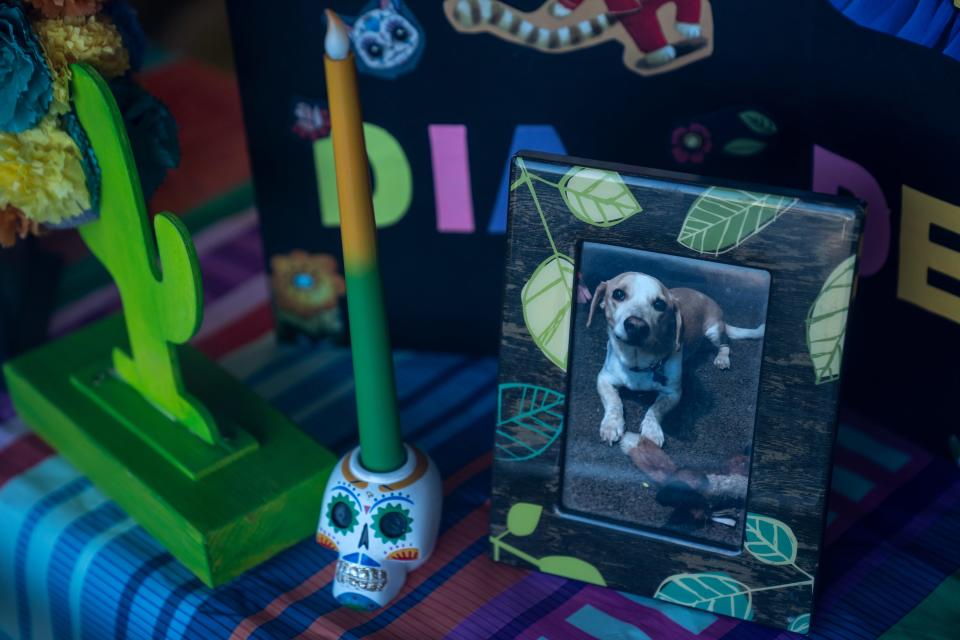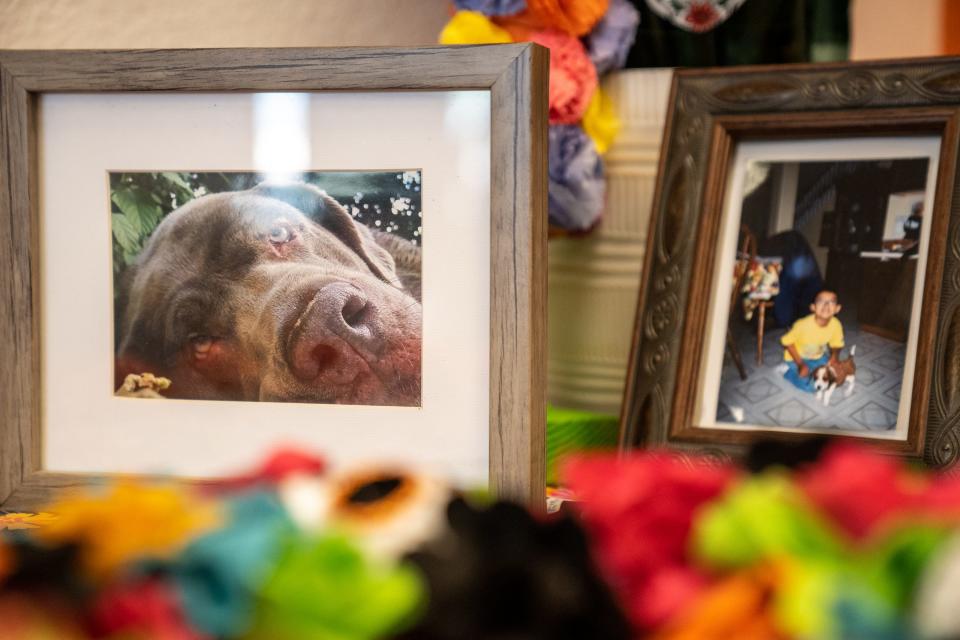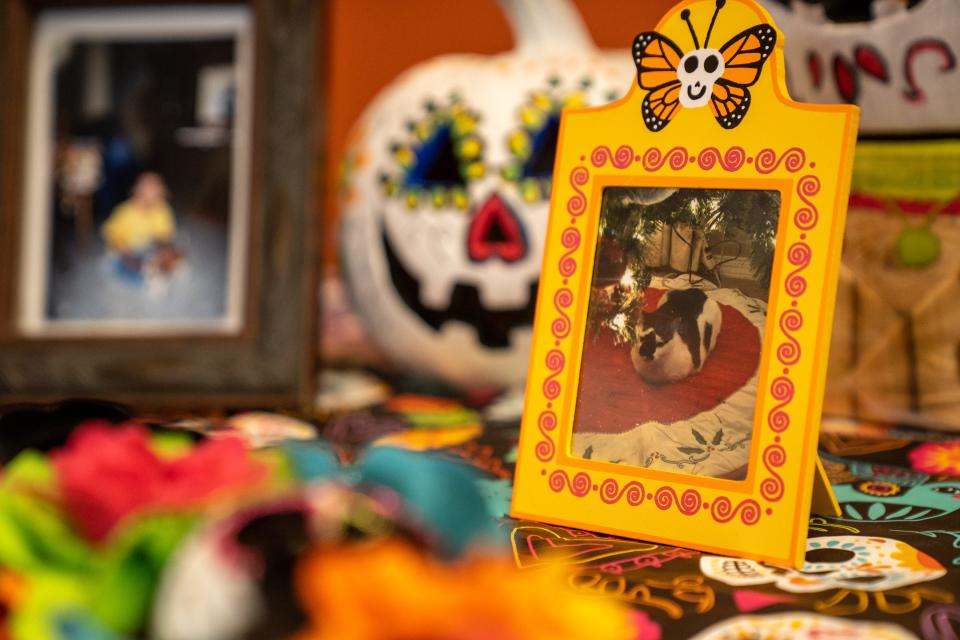A day dedicated to pets during Día de los Muertos: How a south Phoenix org celebrates it
Known for its colorful altars decorated with papel picado, pan de muerto, sugar skulls, yellow marigold flowers and candles, el Día de Muertos, or Day of the Dead, is a Mexican celebration that has transcended borders, has survived the passage of time and has undergone transformations to continues to serve the memory of lost loved ones in the Latino community.
Among the changes that Día de Muertos has experienced is the practice of honoring pets on Oct. 27 by including their photographs on ofrendas, where water, kibbles, their favorite snacks and even their favorite toys are placed.
Such is the case of the operations manager at The Arizona Pet Project, Michele Soto, who, together with her mother, decided to celebrate the Day of the Dead by building a community altar for pets.
"It's really about pets being part of your family," Soto said. "You love them when you meet them, you love them when they're in your life — just like your family — and you love them when they're gone."
Founded nine years ago, the organization offers services throughout the state of Arizona to help people continue to care for their pets and prevent them from ending up being adopted out.

For two years now, Soto has invited the Phoenix community to honor her deceased furry friends by placing her photograph on the Day of the Dead ofrenda in the south Phoenix office, off Baseline Road and Central Avenue.
Her mother makes the decorations by hand at her house and then takes them to the center so Soto and other volunteers can help her put together the offering.
"I really believe that the altar, the Day (of the Dead) and the time to celebrate it, makes the feeling of joy much stronger than that of sadness," Soto said. "You're sad and you have your moments, but you're so much more grateful that you had them."
Remembering lost furry loved ones
Soto lost her 14-year-old cat named Henry in March and seeing his photograph and his favorite toys on the small altar she built for him in his favorite space in her house has helped her overcome the pain that his death caused her.
She said this celebration helps people process their grief after losing someone and that the vibrant colors associated with the altar help people not fear death because it is a natural part of life.

According to Soto, building altars each year for the deceased is a generational and historical defense mechanism instilled in her as part of her culture. Including her pets in this tradition happened organically since she has always considered them as part of her family.
Last year they put a photograph of her mother's pet, a cat named Esperanza (Espi), on the office altar for the first time, since she had died from an illness. In the last years of her life, Espi became Soto's grandmother's best friend as they talked and even watched television together.
Soto said it was interesting to see her grandmother, a 97-year-old woman, experience having a pet for the first time, since when she was a child her family never had pets inside the house.
Soto also said that having a pet is a different experience for people who belong to different generations and cultures.
"Nothing makes my heart happier than seeing someone walk their dog. I find it very cute," Soto said. "But growing up, we didn't walk our dogs on leashes, they would just run around and then come home."

Día de Muertos, a generational celebration brought to the US
Soto shared that growing up she celebrated the Day of the Dead by making altars with “long white candles” in her home but that her main memories are of the days she spent in the cemetery with her family.
Soto said it was like having a “picnic” in the cemetery, since after cleaning the graves of her deceased relatives, everyone would start eating while listening to live music and talking.
Historically, this has been the way people celebrated the Day of the Dead on Nov. 1, known as “All Saints' Day,” and Nov. 2, known as “All Souls' Day,” according to the Catholic calendar.
These characteristic practices of the Day of the Dead were carried out in private in the U.S., but it was thanks to the Chicano Movement that the Day of the Dead celebrations were brought to the public sphere, according to the professor of the Department of Latino and Caribbean Studies at Rutgers University, Regina Marchi.
Inspired by Indigenous and pre-Hispanic rituals more than 3,000 years old, activists and artists participating in the Chicano Movement organized the first public exhibitions of the Día de Muertos in 1972 at the Self Help Graphics & Art gallery located in Los Angeles, California and at La Raza Gallery located in San Francisco, California.
"Part of the Chicano movement was highlighting Mexican traditions and celebrating them with pride in a way that had not been done before," Marchi said. "There was a big movement to embrace multiculturalism and be proud of your roots instead of trying to assimilate and hide your family history."
In addition to promoting Day of the Dead parades, Chicanos were also the first to politicize altars by dedicating them to people who died as victims of domestic violence, workplace abuse and environmental issues, Marchi said.
As the format of altars expanded, people began to consider including their pets, according to Marchi, who is also the author of the book “Day of the Dead in the United States: The Migration and Transformation of a Cultural Phenomenon,” where she compiled his observations and conversations about the celebration of the Day of the Dead in the United States, Mexico and other Central American countries.
As this celebration has gained popularity outside of Mexico, thanks to the 2017 film Coco, Marchi began to observe changes in the altars and public displays that people make to celebrate the Day of the Dead.
Among them is the inclusion of figures of the Xoloitzcuintle — a type of dog native to Mexico that has no hair — since it was the companion of Miguel, the main character of the Coco film.
The Xoloitzcuintle was included in the story thanks to the creators of the Coco film consulting with Chicano and Latino artists, who considered this dog an inherent part of the iconic celebration due to its relationship with Aztec culture.
According to Marchi, remains of bones of the Xoloitzcuintle have been found along with remains of bones of people in Aztec ruins since these dogs were buried with their owners to be together in the other world.
With the arrival of the Spanish, who liked to eat Xoloitzcuintle meat, and the impact of colonization, this dog almost became extinct, and it was thanks to initiatives to keep the Xoloitzcuintle alive during the 1950s that the breed remains alive.
"It is true that this dog (the Xoloitzcuintle) has a history that goes back thousands of years in the Aztec culture," Marchi said. "However, people sometimes like to think of things as a straight line, where this has been an unbroken line of our culture, but in fact when you do that, you are erasing difficulties, such as the impact of colonization on "the cultures, the destruction, and the near extinction of certain practices and the struggles to revive them in trying to bring them back and make them stronger."
This article originally appeared on Arizona Republic: There’s a special day for pets during Día de los Muertos. What to know

